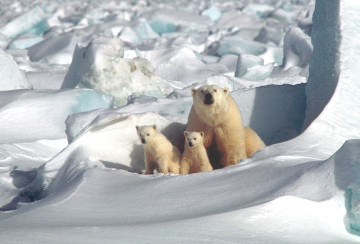Towering alpine peaks, boreal forests, vast tundra plains, meandering alluvial rivers, auburn salt marshes, and sprawling coastal shores make the Arctic National Wildlife Refuge an idyllic haven for its fauna inhabitants. Perched in the northeast corner of Alaska, the remote wildlife refuge has a range of almost twenty million acres, making it the largest wildlife refuge in America’s public lands system. Among the wildlife at home in the refuge are 25 different mammals and over 200 types of birds.
Polar Bear
Polar bears are one of the largest animals found in the refuge—and they are made for the harsh conditions. A four-inch layer of blubber keeps them warm and insulated during the freezing winter months. They even have fur and claws on the underside of their paws to keep their feet insulated against the icy terrain. Even though polar bears have white fur, their skin is black to absorb heat from the sun.
When and where to see them: If you go to the refuge to see polar bears, make sure you read up on polar bear safety. With the exception of pregnant females, polar bears are active near the coast year round. Pregnant females den in the winter month and do not hibernate. Fun fact—the Arctic Refuge has the highest concentration of terrestrial polar bear dens in Alaska.
Gray Wolf
Although called the Gray Wolf, wolves may be seen in shades of gray, brown, black, or white. The gray wolf is an incredibly social animal and is rarely seen alone. Wolves prefer to live in packs. Each pack is run by a male/female pair. Other pack members include pups of that year, wolves born in previous years, and adults who work together to hunt and care for the pups.
When and where to see them: Wolves are primarily found in the mountains and foothills adjacent to major rivers. In summer the wolves spread out. Many of them hunt alone or in single pairs. Some are drifters that move into new areas, potentially to track the caribou migration. In winter months wolves stick closer to together. Wolves mate in late February and March. The pair moves to maternity dens not far from their mountain and river habitats. Pups are typically born in late May or early June. The pups are weaned from their dens during the rest of the summer and leave their nests in July or August. By fall and early winter, young wolves travel and hunt with the adults.
Porcupine Caribou Herd
The 197,000 member Porcupine Caribou Herd is known for its remarkable migration across the refuge. These wandering ungulates can cover almost 3,000 miles in a single year. Named after the major river in the refuge, Porcupine Caribou winter in the southern portion of the refuge and summer in the northern area. By early June, pregnant females reach the calving areas on the arctic coastal plain to give birth. After giving birth, the cows and calves forage in the lush areas of the coastal plain. Come late June or early July caribou come together in masses of tens of thousands to head south. Seeking relief from the mosquitoes and to forage for food, they travel to the coast, onto ice fields, and to the Brooks Range.
When and where to see them: The herds can be seen year round in the refuge. In the summer, they will be in the arctic coastal plains. In the winter they move back east and south to areas near or in the Brooks Range.
All Arctic Refuge lands are accessible and open to the public at all times. However, it is a place "where the earth and its community of life are untrammeled by man" (The Wilderness Act, 1964). There is no wi-fi, cell service, roads, established trails, or any man-made structures within its boundaries. Most visitors have to get to the area by bush plane. Do you research before setting out to this amazing wilderness and come prepared—it is one of the last truly wild environments on our planet.
For more information on what the Sierra Club is doing to protect this national treasure, click here.
Originally written by RootsRated Media for Sierra Club.
